November Fungi Focus: Orange Mosscaps, Orange Bonnets and Moss Bells
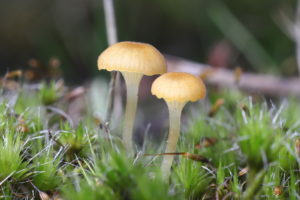
A fungi fanatic with a camera and a macro lens is never bored outdoors. At least, that’s how I tried to console myself when left stranded at a rural train station in East Kent having just missed my hourly train by a matter of minutes and realising that the next one was delayed by a further half hour. A brief wander around the environs to kill time proved me right when I came across a cluster of small grey mushrooms getting up to 2cm in cap diameter growing amongst the moss on a raised grassy patch at the far end of the platform.
The mossy substrate, the indented cap and the widely-spaced gills running down the stem made identification a relatively straightforward business – these were part of the Arrhenia genus, which depending on the species can adopt either a pleurotoid (literally “side-ear form”) form, like the soft brackets we see with oyster mushrooms, or an omphalinoid form, from the Greek word ‘omphalos’ for belly button, with a central stem and decurrent gills running down it and an umbrella-shaped cap with a deep central depression.
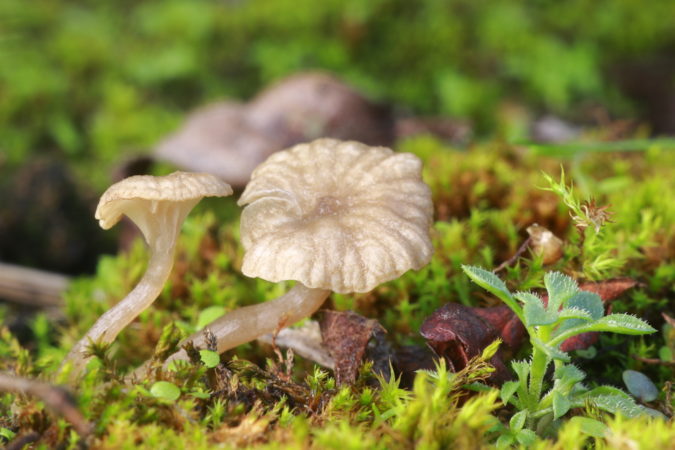
The Moss Navel in classic omphalinoid form with an indented cap and decurrent gills.
Looking at the spores back at home under the microscope corroborated the initial suspicion that these were Arrhenia rickenii, the Moss Navel, which according to its entry on the First Nature website is “a rarely recorded species, probably due at least in part to its small size and the tendency to be obscured by mosses” – and the fact that it is found in such nondescript liminal places as rural train stations, no doubt.
There are numerous species of fungi that can be found growing on moss. Let us for now, however, ignore the tiny disc-like ascomycetes and other even more microscopic “bryophilous fungi” in which the interest is so niche that any information is limited to such specialist sites as this one, and instead focus on a handful of the more obvious mushroom-shaped ones. Most sources will refer to mushrooms such as the Moss Navel as saprophytic, meaning they derive their nutrition from decaying organic material, but with many species associating exclusively with particular species of mosses, many suspect this relationship between fungi and host is probably more complicated, as I alluded to in last month’s post on waxcaps. Yes, to know your bryophilous fungi, you often have to know your bryophytes. And what better place to start than following this link to The British Bryological Society...
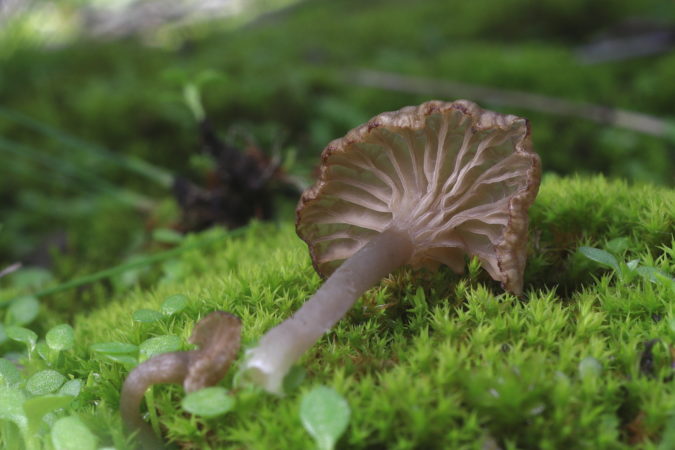
The widely-spaced decurrent gills of the Moss Navel.
The initial issue I had with identifying my find was that different Arrhenia species are found alongside different mosses, and sometimes even lichens. Arrhenia peltigerina, for example, is found alongside the leafy Dog Lichen (Peltigera species), and hence its common name is the Lichen Navel. Arrhenia spathulata, a pleurotoid gill-less species known as the Spatulate Oysterling, is restricted to the moss Syntrichia ruraliformis (“star moss”) found growing on sand dunes or similar environments.
The Moss Navel is not so fussy, it seems, which would probably make it one of the more common Arrhenia species, as is the case with another much smaller and orange-coloured omphaloid, the Orange Mosscap (Rickenella fibula). Actually both of these species were once considered, by dint of their shape, to be part of the same genus, with the Moss Navel previously known as Omphalina rickenii before its renaming to the current monicker in 1989, and the Orange Mosscap referred to as Omphalina fibula.
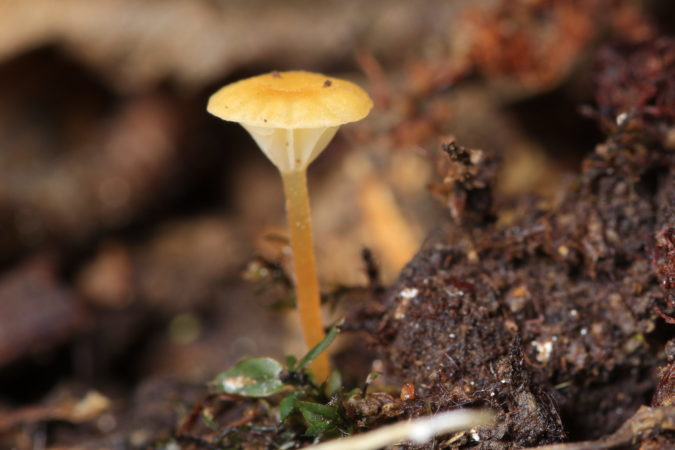
Orange Mosscap
The Orange Mosscap is a mushroom that is easily missed and just as easily misidentified, with a cap diameter of under a centimetre and often much less than that. Unlike Orange Mosscap, it isn’t just restricted to grassland mosses, such as those found in areas such as damp lawns and graveyards, but is commonly found on moss-covered tree stumps or fallen trunks.
While the cap and stem are orange and slightly translucent (the cap can wash out to a paler colour with age), the gills are white, and if you can get a close enough look at them using either a hand lens or a camera macro lens, you will notice that they are strongly decurrent, running down the slender stem and giving the whole mushroom a nail-shaped form. When up close and personal like this, one will also note that both cap and stem are covered in tiny bristles called cystidia, which are relatively large sterile cells found in the fruit bodies of gilled mushrooms that can aid identification.
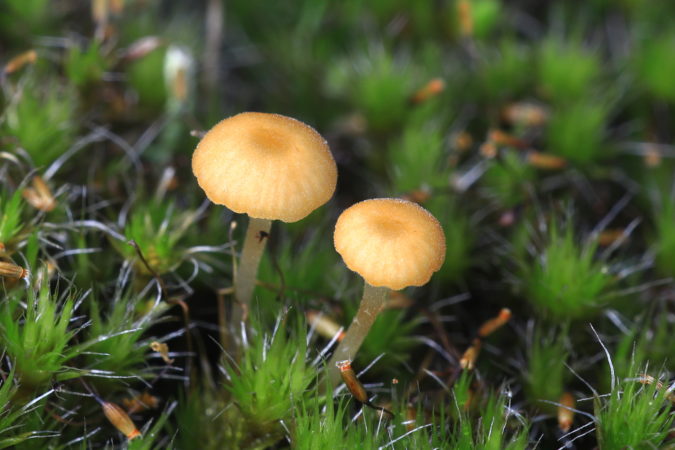
The upper cap surface of the Orange Mosscap, covered in fine hairs that can also be seen on the stem.
The main lookalike mushroom that one is likely to confuse the Orange Mosscap with is the Orange Bonnet (Mycena acicula), whose orange cap ironically makes it the one of the most distinctive of the very difficult Mycena group of mushrooms to identify (see my previous posts on Frosty Bonnets and Rosy Bonnets).
The Orange Bonnet is quite a common find, and again very small, but while it is found in mossy areas, it is deciduous leaf and other woodland litter that is its substrate rather than the moss itself. The cap is pruinose, meaning with a dusty surface, rather than distinctly hairy, but it is the gills one needs to look at – these are adnexed or free rather than decurrent, meaning they are not attached to the stem at all.
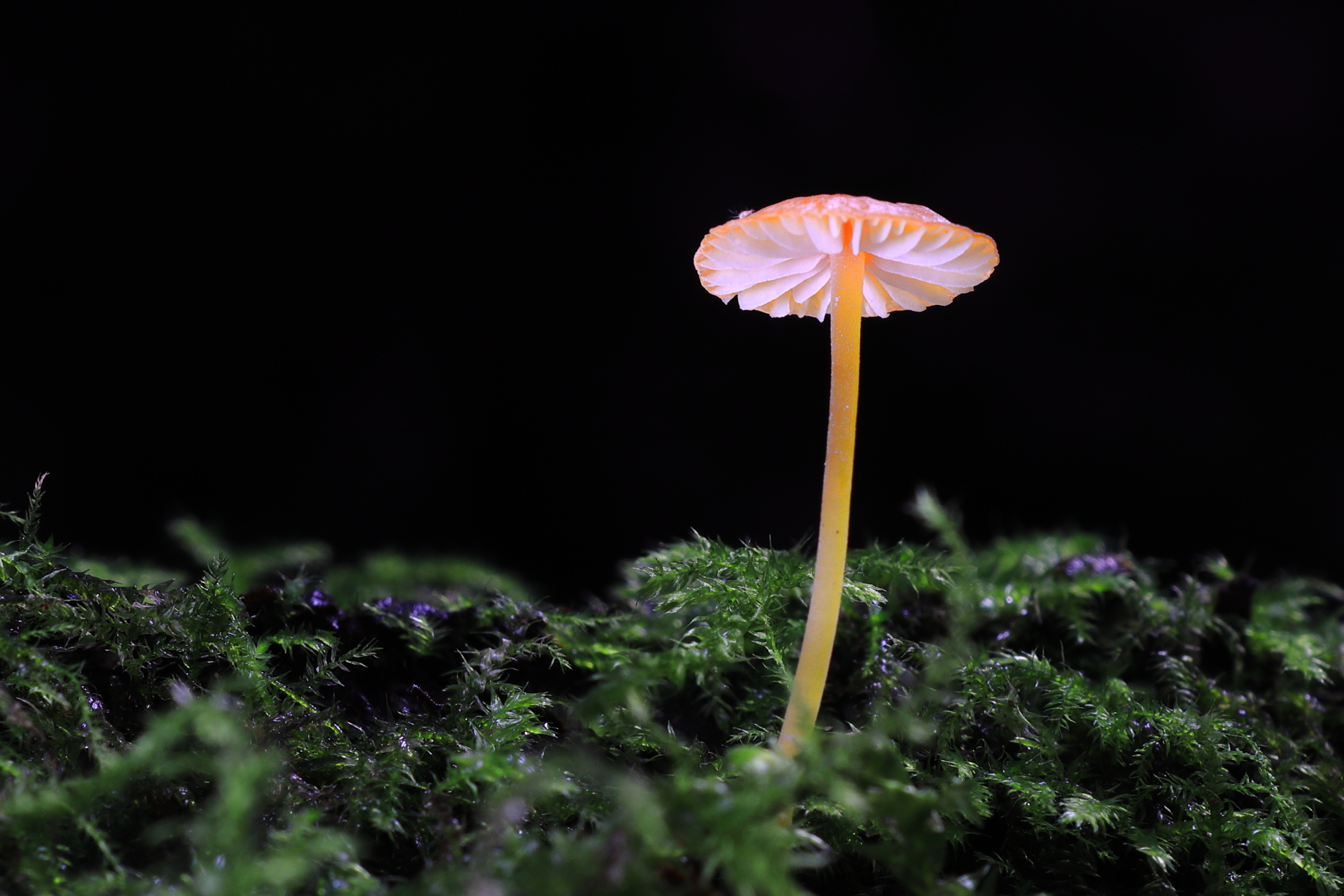
The underside of the Orange Bonnet, with the adnexed gills distinguishing it from the decurrent gills of the Orange Mosscap.
Both Orange Mosscaps and Orange Bonnets have white gills and leave white spore prints, which will distinguish them from the final group of mushrooms to which they might be compared, those in the genus of Galerina. Many of this group fall within the LBM (‘little brown mushroom’) category that most mycologists and forages choose to overlook due to their insignificant size and nondescript appearance, but a few, such as the Moss Bell (Galerina hypnorum), the Veiled Bell (Galerina calyptrata), the Dwarf Bell (Galerina pumila) and the Hairy Leg Bell (Galerina vittiformis) among others, do have small orange caps and are found growing among similar mosses and mossy areas as our previous examples.
These posts, incidentally, are not about foraging, but even though these mushrooms are not of a size to make them culinarily worthwhile, I would strongly advise against anyone ingesting them in the vain hope of some other form of more spiritual nourishment. Many Galerina species contain potentially deadly toxins, most notoriously the aptly-named Funeral Bell (Galerina marginata).
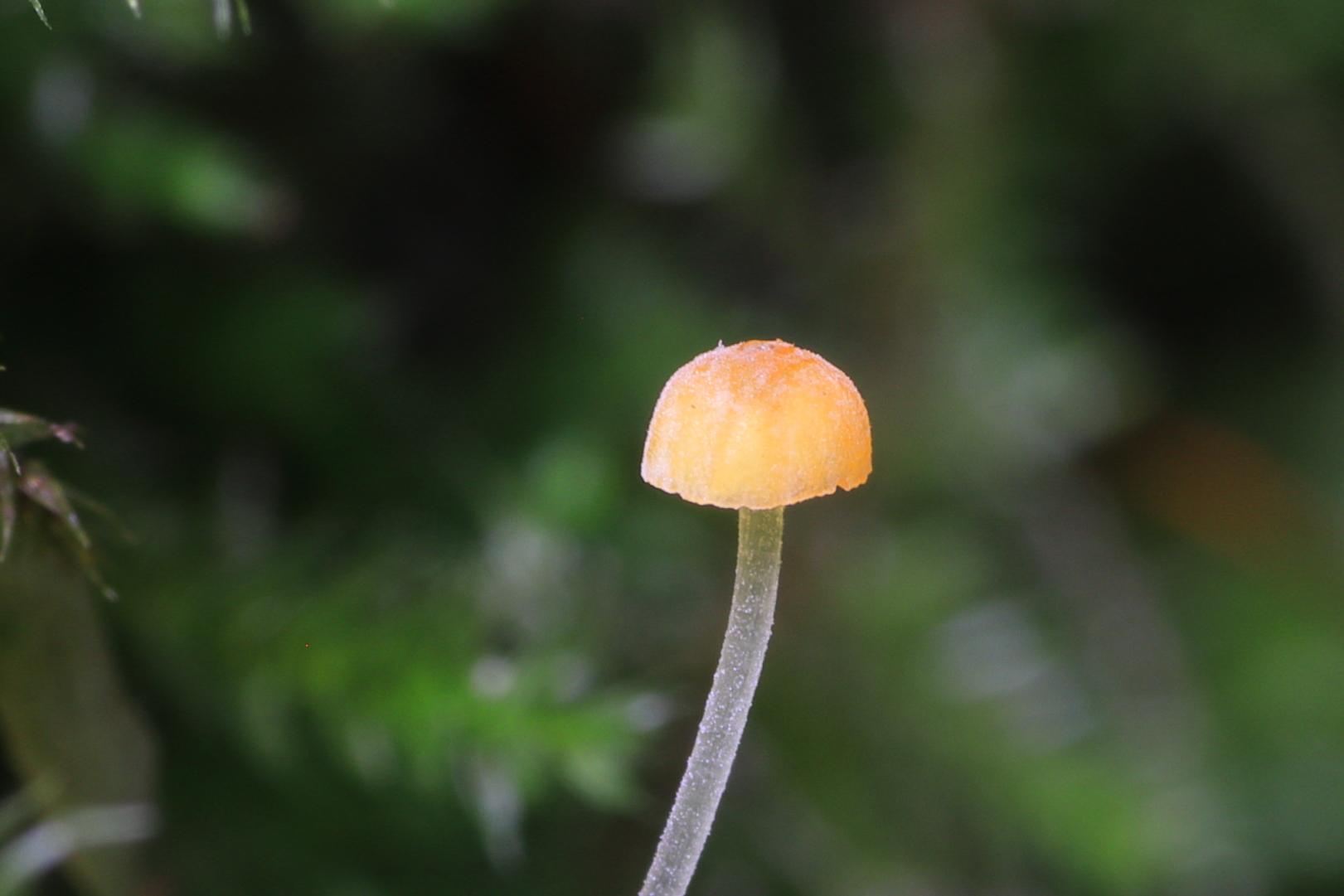
The dusty ‘pruinose’ surface of the Orange Bonnet.
The stem characteristics will provide some help of distinguishing the aforementioned Galerina species from the Orange Mosscaps and Orange Bonnets, and to some extent from one another – they are a lot more fibrous, many with white fibrils running longitudinally down the stipe, and some species have distinct rings around them beneath the cap. The bell-shaped striate cap also marks them out from the omphaloid characteristics of the Orange Mosscap.
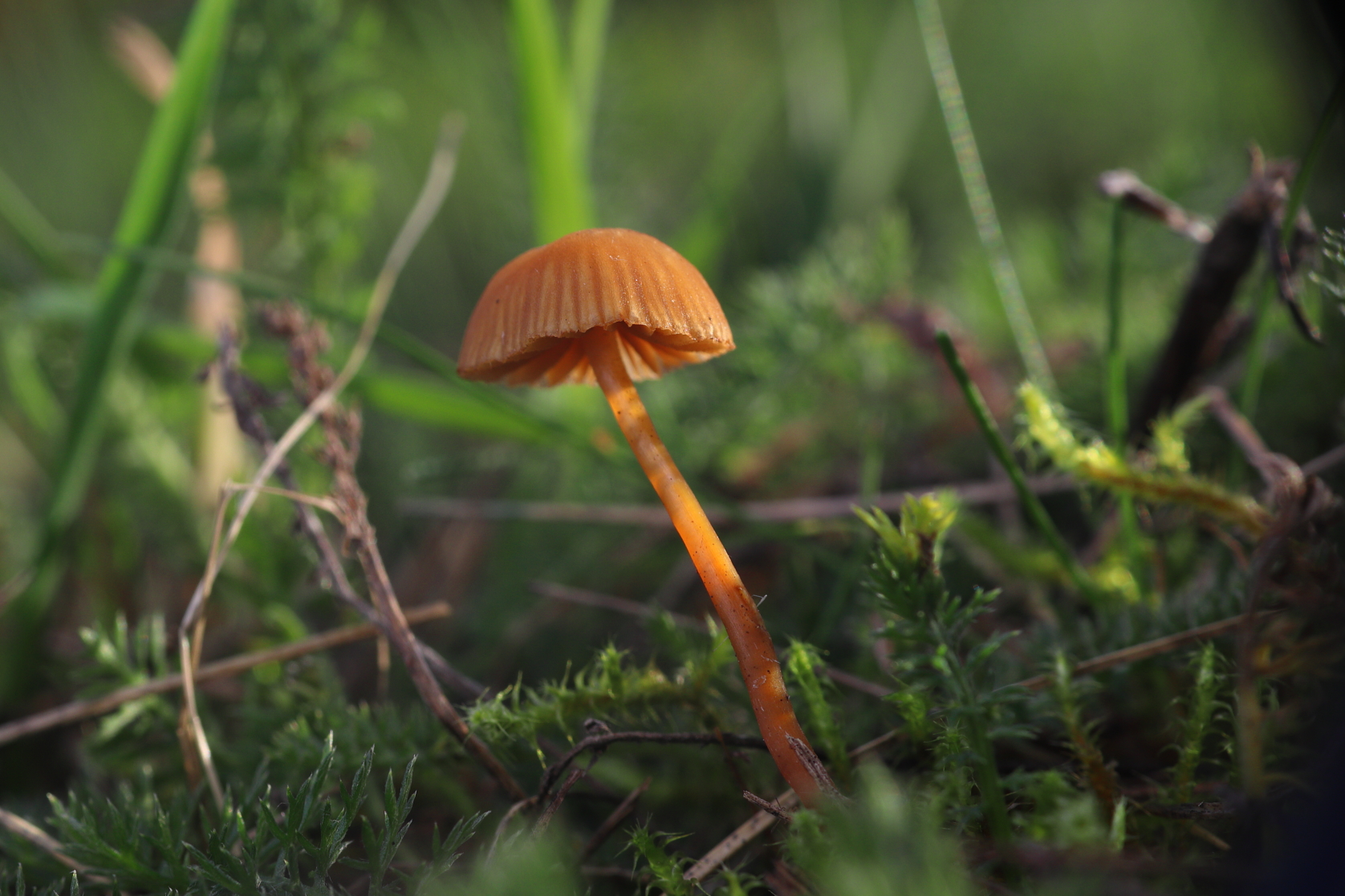
A grassland Galerina in moss, possibly a Hairy Leg Bell. Note the fibrous stem and orange gill colour.
But again, and one cannot emphasise this enough, the best way to work out what you are looking at is to go straight for the gills and spores. Galerina have light orange to rust-brown adnexed gills, neither white nor decurrent, and if you leave them on a piece of paper to get a spore print, the deposit will be accordingly orange to brown, not white. And the fail-proof way of characterising any of these would be to look at the spore size and shape using a microscope and compare against other references such as the First Nature website.
This post is essentially an ode to moss and all that live amongst them, to a substrate that in the dampness of Autumn provides a rich host for a number of species and which one might well want to take a closer look at when seeing what’s about in the woods or pastures.
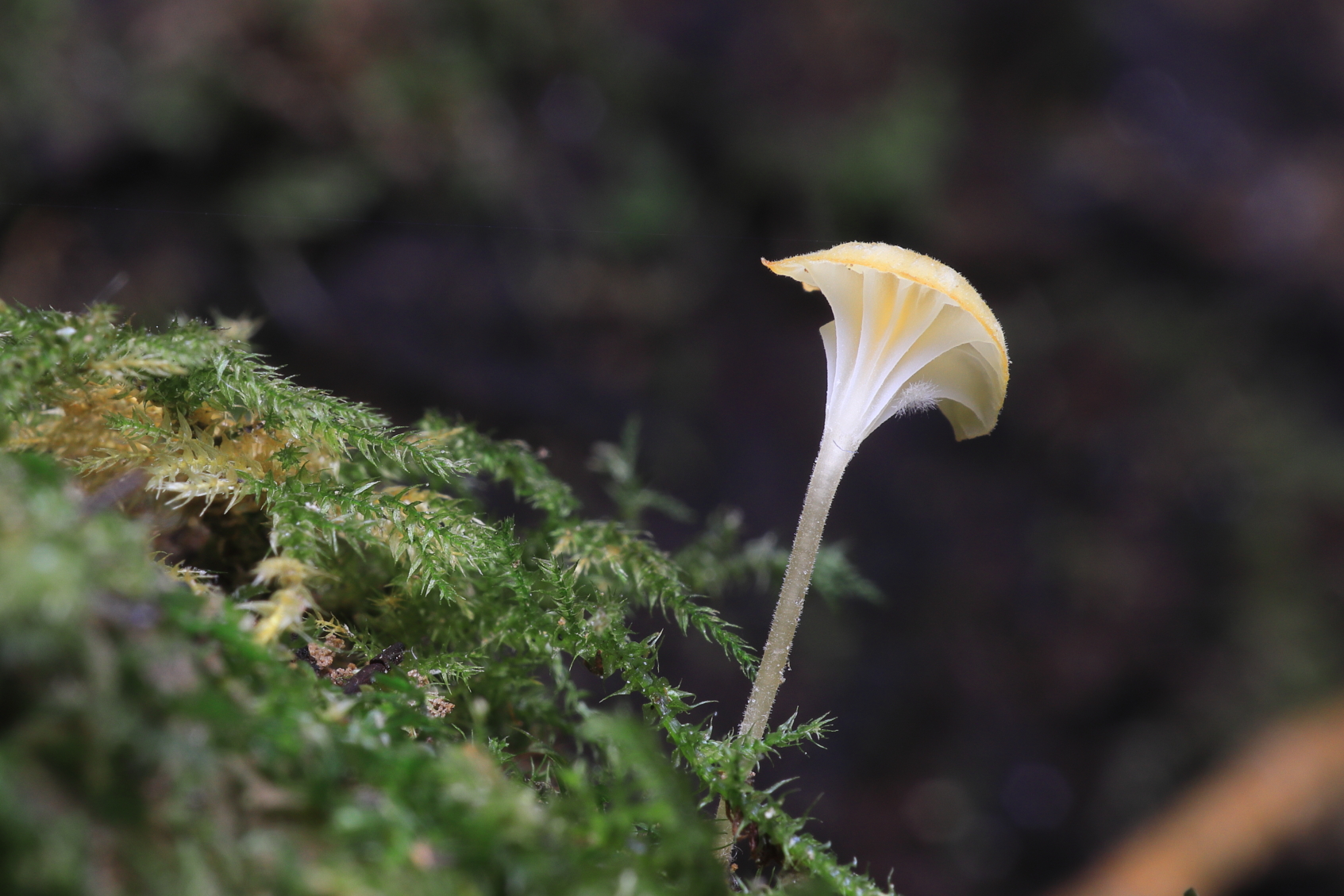
The Orange Mosscap (Rickenella fibula)
Comments are closed for this post.

Thanks for sharing
Peter Doyle
10 November, 2022